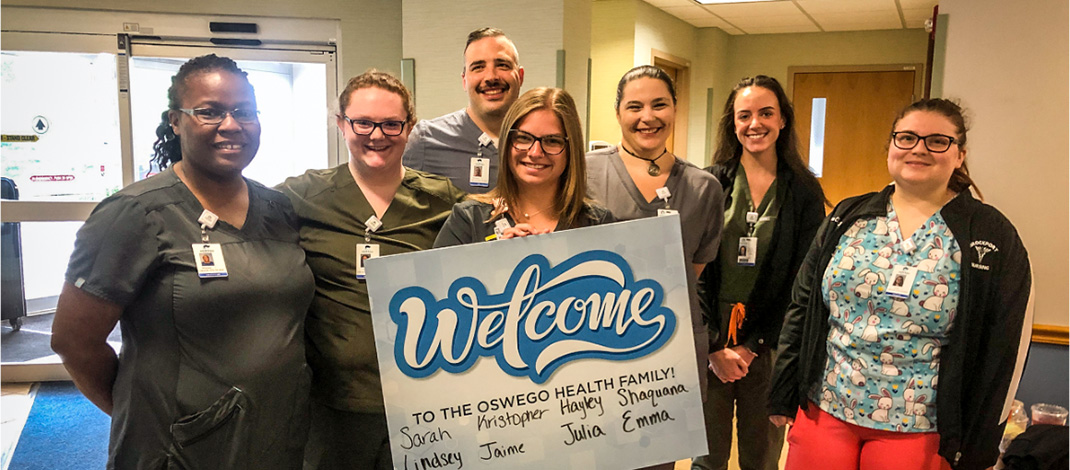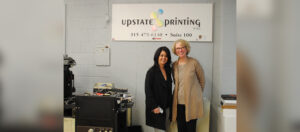Health systems like Oswego Health offer a variety of incentives to recruit and retain nurses
By Deborah Jeanne Sergeant
Retention is only a part of the strategy for addressing the nursing shortage; training and hiring are also essential.
“Hospitals are scrambling to get people to enroll in nursing school,” said George Chapman, owner of GW Chapman Consulting in Syracuse who provides medical practice consulting services to medical groups. “Pay for nurses is good, but it’s a tough gig.”
Chapman thinks that improving the work-life balance may be a way to entice more people to consider entering training to become a nurse. However, nurses who work in hospitals will likely always need to work some weekend and night shifts.
Oswego Health recently hired nine new graduate registered nurses. Oswego Health recruited the nurses from local schools, Cayuga Community College, SUNY Brockport, Pomeroy College of Nursing and Excelsior University.
Part of Oswego’s draw to new nursing graduates is the health system’s tuition reimbursement program, which provides each participant with up to $10,000 per year toward degrees in nursing. Graduate nurses can also advance their careers through the emergency department residency program, obtaining paid on the job training.

“At Oswego Health, our employees are our greatest assets and that’s why we care about reinvesting in them,” said Marq Brown, vice president of human resources and chief people officer. “If they’re looking to advance their training, we’ll help guide them and pay for it. If they need a more flexible schedule to maintain a work-life balance, we’ll accommodate. If they want to go back to school entirely to pursue a healthcare degree in nursing, medical imaging or laboratory science, we offer tuition assistance programs, customized to help them achieve their dreams.”
Oswego Health employs more than 1,300 people among 17 locations in the system. Keeping staffed has been a challenge, as it has been across most of the healthcare sectors. The COVID-19 pandemic only exacerbated the nation’s longstanding nursing shortage with older nurses retiring before they anticipated and burned-out nurses of every age quitting for other types of work.
The Department of Labor states that the average turnover rate nationwide is 17.1% for registered nurses. Since half the RN workforce is at least 50 years old, according to the National Council of State Boards of Nursing, more than a million nurses will reach standard retirement age within the next 15 years.
Unfortunately, cash-strapped hospitals spend between $37,700 and $58,400 per nurse for turnover, which includes the cost of recruiting, hiring and training. That makes hiring more nurses challenging. Many hospitals with razor-thin margins found that the pandemic made their budgets even tighter.
One of the reasons that employers like Oswego Health must work so hard to find graduate nurses is the pool is so small. It’s not that too few people want to work as nurses, but too few people are accepted into nursing programs. The National League of Nursing states that the bachelor’s in nursing (BSN) programs accept only one-third of qualified applicants. These are applicants with aptitude and a high GPA.
Of course, high standards should be part of the decision-making process. However, the capacity of schools also curtails acceptance rates. The size of the school’s faculty presents a major bottleneck factor. Nurses make more money practicing than teaching. The equipment and facilities for training nurses are very costly. That is why many BSN courses are at “teaching hospitals” like Upstate Medical University.
At Cayuga Community College, students can train in the associate degree program and begin working or transfer to another school to finish a BSN.
“Cayuga has one of the best associate’s degree programs in New York, with graduates regularly accepting healthcare positions in the region shortly after graduation,” said Andrew Poole, director of Public Relations and Institutional Communications. “More than 97% of our graduates since 2018 have passed the NCLEX on their first try, including 100% of our graduates in 2021 and 2022. This is well ahead of state and national averages.”
Nursing Schools Almanac and RegisteredNursing.org has recognized CCC as offering one of the top nursing programs, which includes classroom and clinical settings and nursing labs at both the Auburn and Fulton campuses.
“Among the diverse skills emphasized in Cayuga’s program, students practice professional standards of registered nursing, patient-centered care, patient and family advocacy, implementing safe clinical judgments through evidence-based practice, and developing communication skills to best work with their patients and their patients’ families,” Poole said.
To complete their education, undergraduate nurses also need places to perform their clinical rotations as required by the State Boards of Nursing. This became so challenging during the pandemic that many schools could provide to students use only simulation rather than caring for actual patients under supervision. But even under normal circumstances, it can be tough to find sufficient spots.




